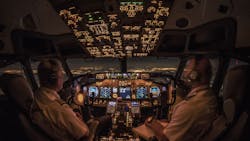Minimizing EMI in Commercial Aircraft (.PDF Download)
The FAA advisory circular, AC 91.21-1D, “Use of Portable Electronic Devices Aboard Aircraft,” prohibits operation of portable electronic devices (PEDs) not installed aboard U.S. registered civil aircraft, while operating under instrument flight rules (IFR). The measurement of the radiated field coupling between passenger cabin locations and aircraft communication and navigation receivers, via antennas, is called interference path loss (IPL).
Boeing states that operators of commercial aircraft have reported numerous cases of PEDs affecting aircraft systems during flight. This article will delve deeply into this controversial subject of electromagnetic interference (EMI) in commercial aircraft. Let’s see what one of the largest aircraft manufacturers has to say on this subject.
